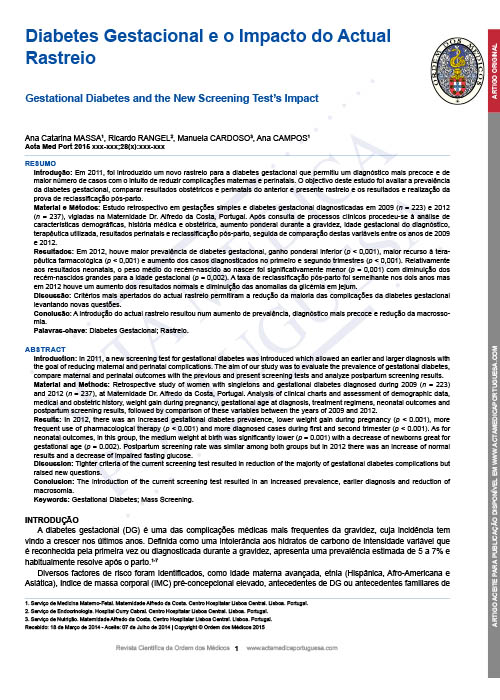SOCIAL MEDIA
Portuguese Medical Association's Scientific Journal

Introduction: In 2011, a new screening test for gestational diabetes was introduced which allowed an earlier and larger diagnosis with the goal of reducing maternal and perinatal complications. The aim of our study was to evaluate the prevalence of gestational diabetes, compare maternal and perinatal outcomes with the previous and present screening tests and analyze postpartum screening results.
Material and Methods: Retrospective study of women with singletons and gestational diabetes diagnosed during 2009 (n = 223) and 2012 (n = 237), at Maternidade Dr. Alfredo da Costa, Portugal. Analysis of clinical charts and assessment of demographic data, medical and obstetric history, weight gain during pregnancy, gestational age at diagnosis, treatment regimens, neonatal outcomes and postpartum screening results, followed by comparison of these variables between the years of 2009 and 2012.
Results: In 2012, there was an increased gestational diabetes prevalence, lower weight gain during pregnancy (p < 0.001), more frequent use of pharmacological therapy (p < 0.001) and more diagnosed cases during first and second trimester (p < 0.001). As for neonatal outcomes, in this group, the medium weight at birth was significantly lower (p = 0.001) with a decrease of newborns great for
gestational age (p = 0.002). Postpartum screening rate was similar among both groups but in 2012 there was an increase of normal results and a decrease of impaired fasting glucose.
Discussion: Tighter criteria of the current screening test resulted in reduction of the majority of gestational diabetes complications but raised new questions.
Conclusion: The introduction of the current screening test resulted in an increased prevalence, earlier diagnosis and reduction of macrosomia.
Keywords: Gestational Diabetes; Mass Screening.